

The state of Illinois is usually associated with the city of Chicago, the unofficial capital of the Midwest and the home to a majority of the state's residents. Indeed, all of my previous trips to Illinois had taken me to Chicago for one reason or another. However, there's a whole rest of the state that usually tends to be ignored, with its own sights to see and places to visit. The focus of today's trip was the state capital of Springfield, which is located in the geographical center of Illinois. I wanted to visit Springfield due to its strong associations with Abraham Lincoln, the place where he spent most of his adult life before being elected president. Springfield is the definitive place to visit for anyone who is a Lincoln fan (as I am), and this trip would be a tour de force of Lincoln-associated artifacts, from his preserved house to his law office to his tomb. For anyone who isn't particularly interested in Lincoln, you might want to skip this page and move on to a different one because there isn't much in Springfield unconnected to the former president.

Before I could tour anything in Springfield, I had to drive there first. The route was about as simple as it could be from Indianapolis, a straight path to the west along Interstate 72 through western Indiana and eastern Illinois. I was up at 6:00 AM and the roads weren't especially crowded on this Monday morning, just carrying the normal steady flow of traffic that never completely dies down on a major interstate. I had earlier looked at the route from Indianapolis to Springfield, and I'd noticed that the road passed directly through Champaign, the home of the University of Illinois. Since I was making good time, I decided to stop in Champaign and spend an hour walking around the Illinois campus. I had a devil of a time trying to find a place to park without paying, as every lot seemed to have tow-away signs (much like the campus at my own University of Maryland). I finally ended up parking in a residential neighborhood well to the north of the campus, across the railroad tracks, and walking about six blocks until I reached the outskirts of the main campus.




I found this charming brick wall with the University of Illinois logo on it next to University Avenue, where I could see a bunch of apartments and retail stores running off into the distance. I crossed the busy street and walked among the buildings on the northern quad, which mostly seemed to house the engineering and scientific departments. It was a beautiful sunny morning and the campus was predictably deserted at 8:00 AM in the middle of the summer. These buildings seemed to be mostly constructed out of bricks and the morning sunlight was tinting them with an orange glow that matched the colors of the university. I made my way down to the Bardeen Quadrangle where there were more laboratory buildings and crossed over a little stream, which is apparently known as Boneyard Creek. As I've said before, every college campus should have a river running through it somewhere, and this one was suitably picturesque.




As I continued heading to the south, I came across this stately-looking building. This was the Illini Union, built in the 1940s on the site of the original university hall to serve as a home for student organizations and student activities. The doors were open when I arrived and the interior was surprisingly upscale, with wood paneling decorating the walls and chandeliers hanging from the ceilings. There were large fireplaces at the end of the entry hall that would presumably be lit during the cold winters in central Illinois. It turns out that the Illini Union is also an expensive hotel that caters to prestigious guests of the university. This impression was spoiled somewhat by the college-age student sleeping on one of the fancy-looking couches. Downstairs was also another matter, where the hotel atmosphere gave way to the typical accoutrements of a student union, with fast food restaurants, cafeteria-style seating, an arcade, and a bowling alley. Nonetheless, this was one of the more unusual student union buildings that I've seen due to the presence of that hotel. I didn't expect to find anything quite so chic on the Illinois campus.

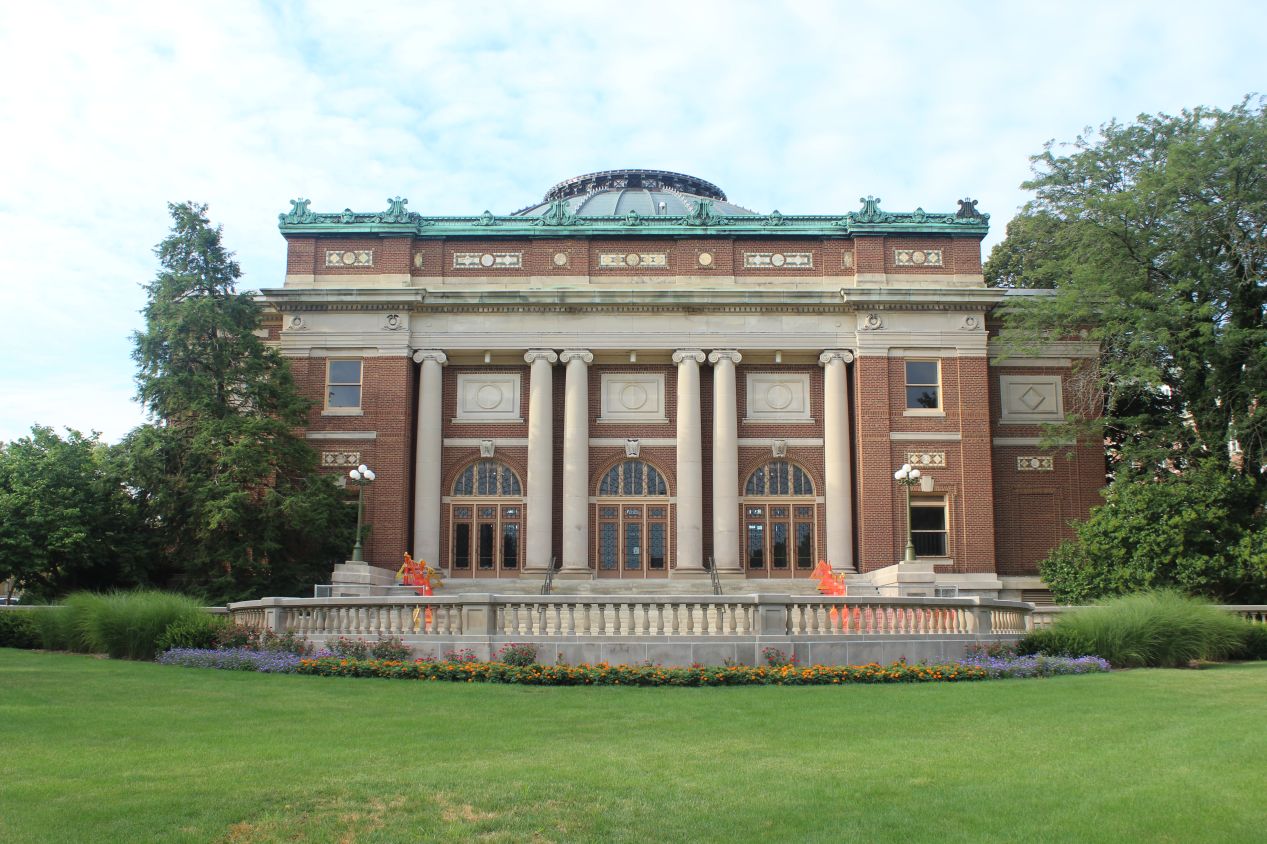


Further south beyond the Illini Union was the campus main quad, the largest green space on the Illinois grounds. The union sits at the northern end of the quad while Foellinger Auditorium, the round building pictured above, anchors the southern end. Unfortunately this historic building from 1907 was locked when I checked to see if I could go inside; it houses the largest lecture room on the Illinois campus. Immediately behind the auditorium was the undergraduate library, but there was no structure to be seen in this case because most of the library is located underground. The university is known for its gigantic library collections, which are supposed to be the second-largest at any American university behind only Harvard. There was yet another quad located to the south of the undergraduate library, this one known as the South Quad, and by this point I was starting to wonder at the size of the Illinois campus. It was almost 1.5 miles from the northern end of the campus to the southern end; this place just kept on going and going. That was probably the biggest surprise of my visit, the huge size of the university. Illinois has 45,000 total students (as of 2018) and that was significantly larger than the other universities that I'd seen thus far on my trip.
Anyway, there was also a carillon rising up above the grass on the South Quad. This is known as McFarland Memorial Bell Tower, and it is not a historic part of the Illinois campus as it was built in 2008. This is not one of those universities with a long tradition based around a memorial tower and the ringing of the bells. The tower stands at 185 feet / 55 meters and contains 49 bells at the top, which were built in the Netherlands and shipped to Champaign. Apparently the Illinois students have decided that the bell tower looks similar to the tower with the eye of Sauron from the Lord of the Rings movies, and I have to say that I see the resemblence too.




I turned west on Peabody Drive and walked towards the athletics complexes at the southern edge of the Illinois campus. The most distictive structure was Memorial Stadium, the home to the football team, with its brick facade and Greek columns along the sides. The stadium is old enough that the "memorial" in its name refers to Illinois students who died in the First World War, not the Second, and the football team has been playing here since 1923. The current seating capacity is about 60,000 and that makes Memorial Stadium one of the smaller locales in the Big Ten conference. There's a statue to Red Grange outside one of the side entrances, which proudly proclaims that he was "the greatest player in college football history", a rather bold claim indeed given that Grange played from 1923-1925. The fact that Illinois is still advertising the exploits of a player from nine decades earlier pretty much tells the story of their football program, which has been a doormat for decades. Technically Illinois football has won five national championships, but they date from 1914, 1919, 1923, 1927, and 1951 - all of them well before the modern era. The team has similarly won 15 Big Ten conference titles, but again only three of them have come since 1963 and only one of them has occurred in the 21st century. Based on the 2018 incarnation of the team, Illinois football doesn't look to become a powerhouse any time soon.




Illinois basketball has been much more successful in recent memory, routinely ranked in the Top 25 and with a visit to the national championship game as recently as 2005 (which they lost to a stacked North Carolina team). The basketball team plays in Assembly Hall, the uninspiring concrete dome pictured above that dates back to 1963. It's a tough place to play a road game and the arena is frequently full of raucous students on those cold winter nights when the team is playing. The basketball court pictured above is not from the arena, but rather from the student recreation center on campus, which is located near the football stadium. I was able to go inside and take a quick look, but couldn't actually use anything inside without a student ID. I headed north from there up Wright Street and stopped in the Illini Union Bookstore, which had two full floors of Illinois merchandise. While I personally don't think that orange and blue is the most attractive color combination, I suppose it works for them. Finally, the stone building pictured above is Altgeld Hall, built in 1897 in Romanesque style to house the university's architecture program. It currently houses the math department, and the tower contains its own set of bells that perform special concerts. Aha - you knew there had to be a memorial bell tower located somewhere on the campus!
Due to the huge size of the Illinois campus, it took me longer to see the sights than I'd been expecting. Rather than spend one hour in Champaign, I ended up spending two. I also found myself walking close to five miles in circling about the campus, and I still hadn't even reached my main destination for the day yet. This was going to be one of those long days of sightseeing.




When I arrived in Springfield about an hour before noon, the first place that I headed was the Lincoln Home National Historic Site. This is located near the center of the small city, where there are four blocks that have been designated as a historic site and the old houses there preserved for posterity. On the map in the visitor's center pictured above, these were the four blocks pictured in dark green, located a short walk away from the historic Illinois capital building. These four blocks were the location where the Lincoln family lived in Springfield from 1844-1861 prior to his election as president. About half of the houses that stood here originally have survived down to the present, and the area is carefully maintained by the park service to try and recreate what the neighborhood would have looked like in 1860, right down to the Lincoln campaign posters on a wooden wagon. This small area looked beautiful on this sunny day, and it was hardly crowded with only a few families strolling around with their kids.


The focus of the historic site is the actual Lincoln house, which has been preserved as well to look as it would have in 1860. Visitors can only see the Lincoln house by taking a tour, which I had no trouble doing since there were so few people present on this day. I showed up to the visitor's center and was able to join the next tour leaving 10 minutes later. Our guide explained that this building was the only house that Abraham Lincoln ever owned, and it was the location where all four of the family's children were born. The structure was snaller when the Lincolns purchased it, and they expanded the structure several times over the two decades that they lived here, with the future president doing much of the construction work himself. This was a prosperous family due to Lincoln's law practice but not an extravagently wealthy one, and their neighborhood included a diverse mixture of people from different backgrounds, everyone from recent immigrants who barely spoke English to a widow who was surviving off of local charity. It seems like it would have been a pleasant place to live by mid-19th century standards.

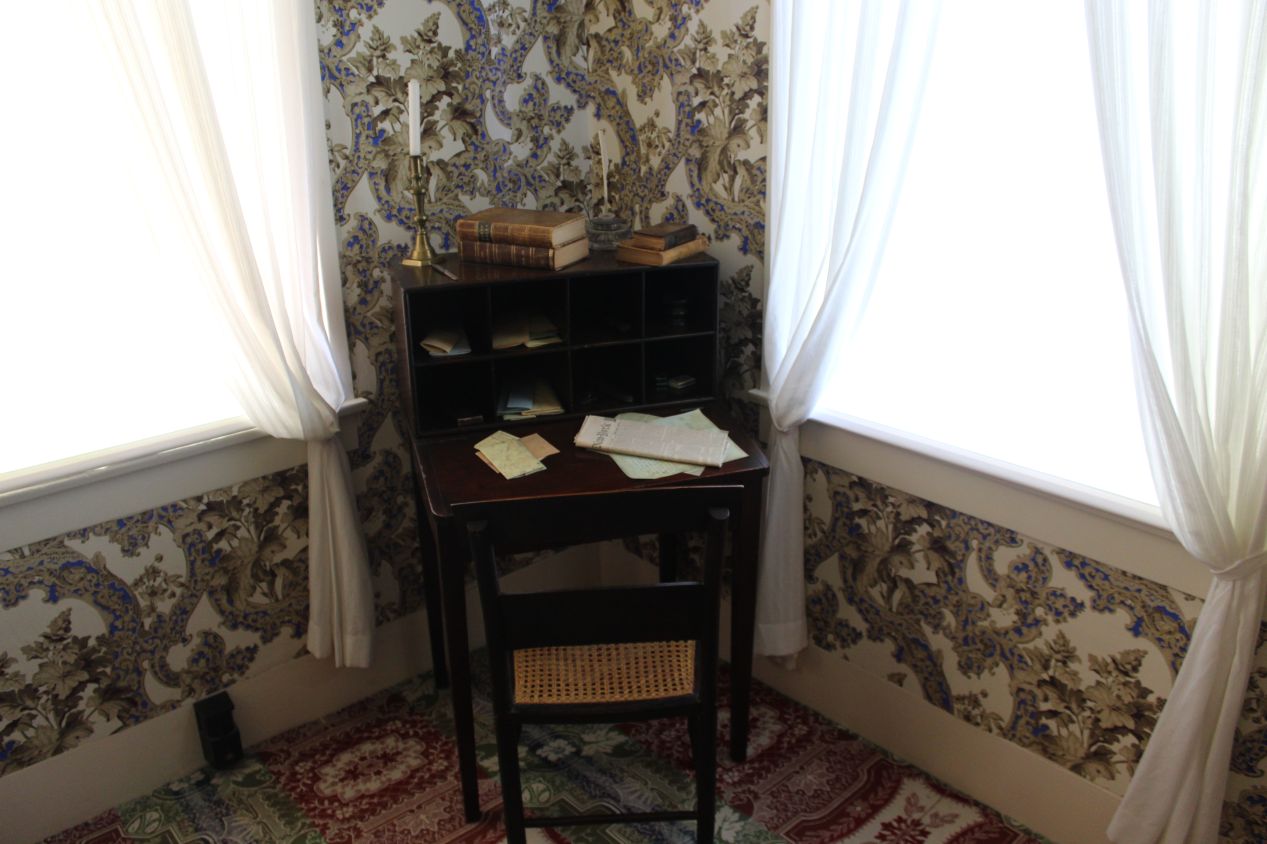


The tour of the Lincoln home takes visitors through all twelve rooms in the structure, on both the ground and upper floors. Our tour guide told some charming anecdotes about how Abraham Lincoln liked to wrestle on the floor with his young sons, with the kids making tons of noise and running wild through the neighborhood. By all accounts, the Lincolns were loving and indulgent parents. The upstairs rooms contained Lincoln's writing desk and two different beds in separate rooms. It was apparently common for couples to sleep apart in this period, and the Lincolns had four children together so there doesn't appear to have been a lack of passion in their relationship. We were also able to see the rooms for the Lincoln kids upstairs, and the kitchen area in the back room. There was also an outhouse in the backyard with THREE holes in it side-by-side, which completely baffled me. Uh, would you really want two other people in the outhouse with you at the same time?  Perhaps personal modesty was a bit different in that era.
Perhaps personal modesty was a bit different in that era.



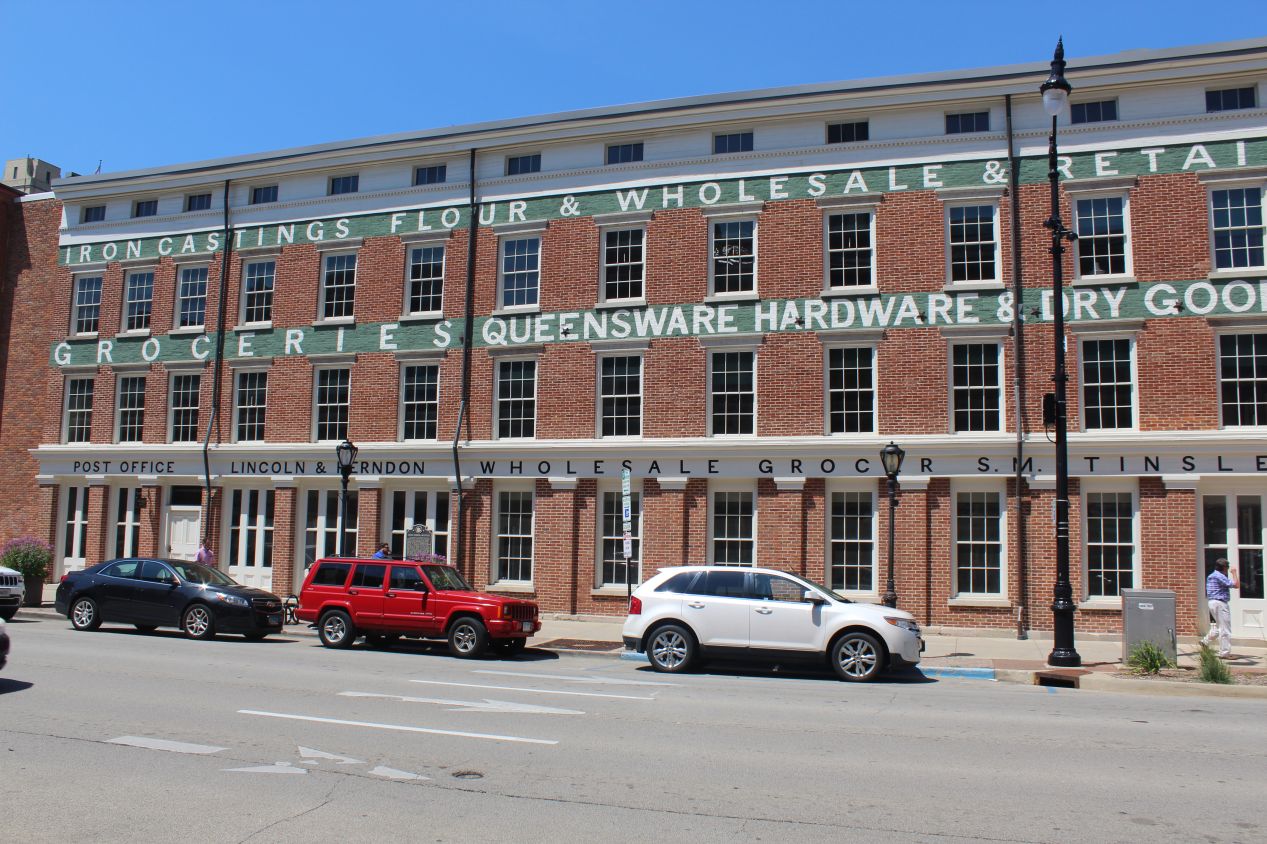
After finishing the tour of the Lincoln Home, I walked towards the historic center of Springfield where the Old State Capitol building was located. The small city was showing its best face today, with a series of walkable streets running between historic brick buildings under a cloudless blue sky. There was a blend of old and new here, with modern storefronts and small cafes located on the ground floor of these buildings while the structures themselves often looked like they were more than a century old. I passed by the location of Lincoln's law practice along the way, which was only about three blocks from his house. The office itself was not open, and it's unclear to me what this building is being used for at the moment.




Sitting in the heart of Springfield is the Old State Capitol building for the state of Illinois. This was the fifth building to serve as the home of the Illinois legislature, and the first one located in Springfield after it was chosen as the new location for the state capital in 1839. The Old State Capitol building was constructed in the Greek Revival style back in 1840, with the same design style using columns at the building entrances and a central dome that became commonplace for state capitals across the USA. As an old structure dating from nearly two centuries earlier, it was quite small and the state of Illinois obviously outgrew the location over time. This building originally held both houses of the Illinois legislature along with the governor's office and the Illinois Supreme Court. I find it fascinating how the whole state government could be run by a little more than a hundred people out of this one building; for better or for worse, governments were vastly smaller at that time.




The upstairs floor held the two legislative chambers, for the Illinois House of Representatives and the Illinois Senate. The House of Representatives was the first of the two rooms pictured above, the one with the large painting of George Washington in the center. This room is most notable for holding the final public viewing of Abraham Lincoln's coffin before it was placed in a tomb to the north of Springfield. Then as now, the Illinois Senate was the smaller of the two chambers, with seats for about 30 individuals as opposed to the roughly 100 seats in the House of Representatives. I enjoyed the small details in these restored rooms, like the iron stoves in the corners of the chambers that were needed to keep them warm in an era before modern heating. The Old State Capitol building hasn't been in use by the state government since 1876, when it moved to the current and much larger state capitol building, but this location continues to hold a great deal of symbolic significance. It was the spot where Abraham Lincoln formally launched his campaign for the Senate in 1858, and more recently was the location where Barack Obama launched his own campaign for president in 2007. This structure is a living symbol of the past, present, and future of the state of Illinois.

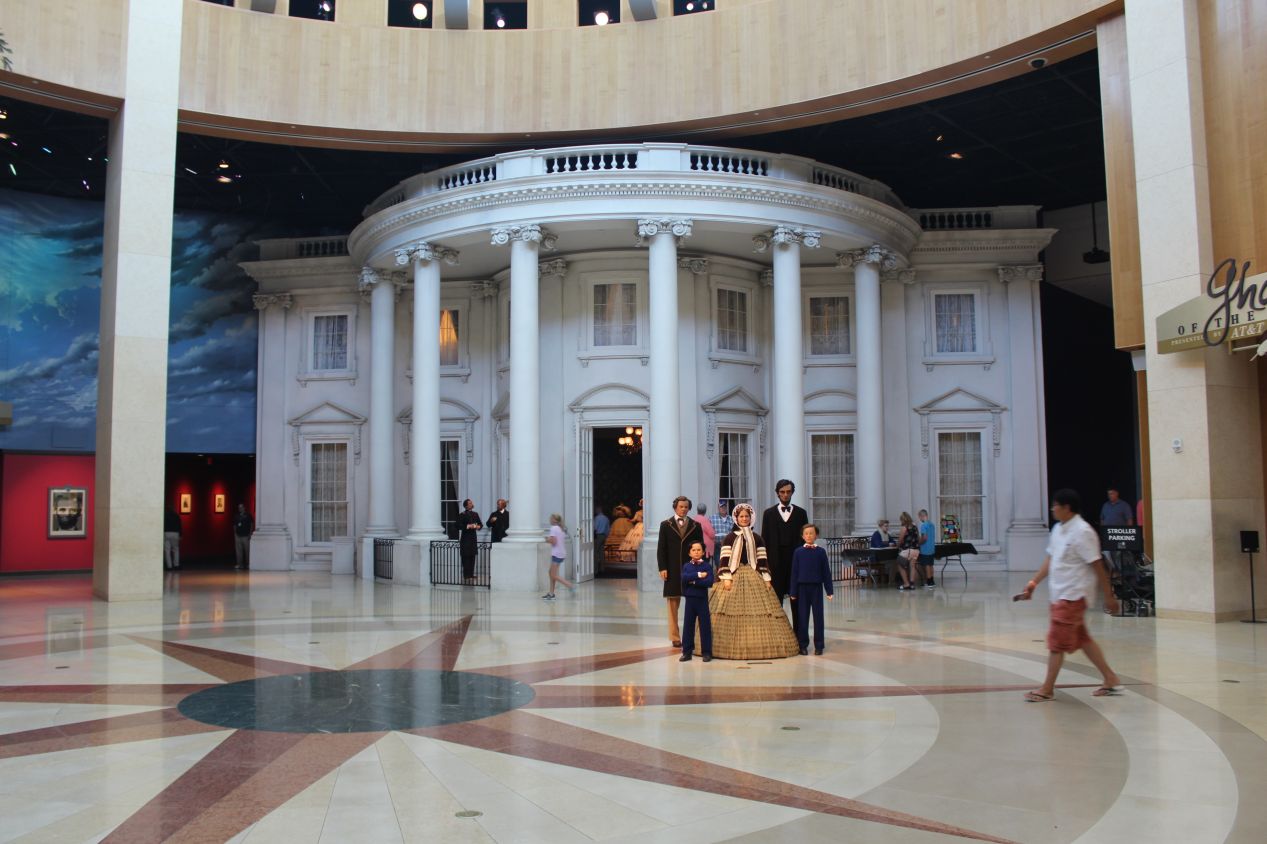


Only a short distance away from the Old State Capitol is the Abraham Lincoln Presidential Library and Museum. This is a large, modern building that stretches across several blocks and tells the story of Lincoln's life and presidency. It's been criticized by some historians for being a bit too much like a theme park, "Six Flags Over Lincoln" as one individual mockingly derided it, but as far as I could tell the information that it presented was historically accurate. History is a fascinating subject and there's no reason why it can't be presented in an interesting and exciting fashion. If it helps bring people to the museum to have life-sized replicas available to take selfies with, I'm fine with that. (My one complaint was that I wish there had been more Lincoln artifacts on display, as there were only a handful of them here and only in one small part of the museum.)
The first exhibit that I saw at the museum detailed the four presidents connected with the state of Illinois in some fashion: Lincoln, Grant, Reagan, and Obama. Out of these four, Reagan's ties to Illinois are tenuous at best; he was born in Illinois and grew up in the state, but his entire professional and political career was associated with California. Grant also spent relatively little time in Illinois, as he was born in Ohio and spent most of his life traveling from one location to another as part of his military career. That said, he did consider Galena, Illinois to be his permanent home and his Civil War career began as an officer commanding Illinois volunteers. Lincoln and Obama are the two presidents who are most associated with Illinois (although neither one was born in the state), developing their respective careers in local Illinois politics before moving on to the national stage. There were speeches and artifacts of all four men on display here, with the most impressive item in the collection being the table from Appomattox Courthouse where Lee surrendered to Grant. I have to say though, it looked pretty much like an ordinary table.

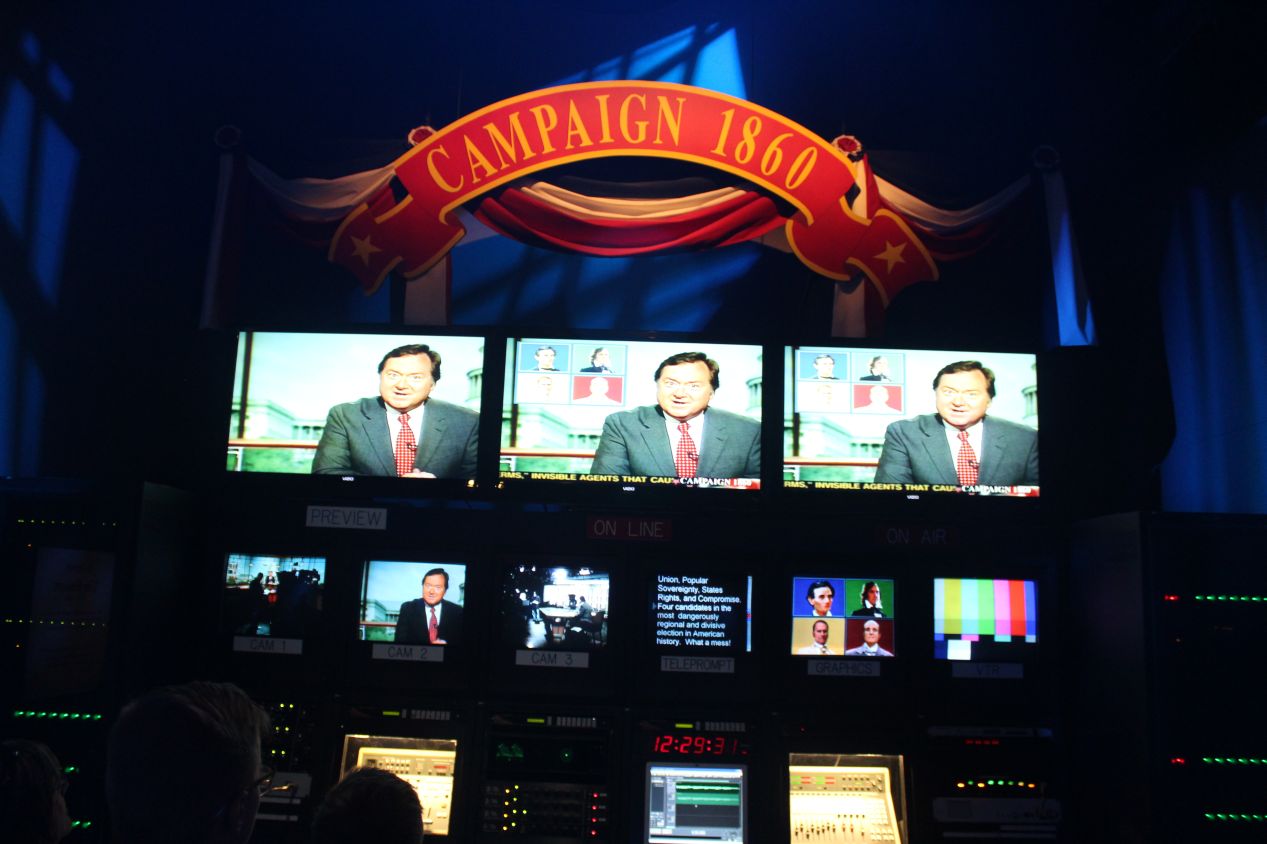


The featured exhibit at the museum runs through two parts, chronicling the life of Abraham Lincoln first in his pre-presidential days and then after he was elected to the White House. The first part started with displays of Lincoln as a boy growing up in a log cabin (including a full reconstructed log cabin with replica Lincoln inside), then moved on to Lincoln's political campaigns, most of which were failures prior to winning the presidency. There was a fantastic video here featuring the late Tim Russert that pretended to apply the modern cable news cycle to the election of 1860, complete with fake TV campaign ads for Stephen Douglas and John Breckinridge. Fantastic stuff. Then the second part of the exhibit led visitors into a model of the White House and walked them through the many controversies of the Lincoln administration as the Civil War raged in the background. I appreciated the room full of political cartoons demonstrating how Lincoln was often controversial and not at all popular during his presidency, and a series of photographs from 1860 to 1865 in which it looked like he aged three decades over those five years. There was a particularly well done room covering the issuing of the Emancipation Proclamation, with voices of about a dozen different perspectives arguing for and against the document. As a history Ph.D myself, this was great stuff and really helped to put people who had little background on this period of history into the biggest issues of the day.


The exhibit concludes with a mockup of the presidential box at Ford's Theatre on the night when Lincoln was assassinated, and then his coffin on public display in the Old Capitol Building, the same place that I had just visited two blocks away. It was genuinely moving to see the funereal display after having spent the last hour going through the story of Lincoln's life. This was a family struck by tragedy after tragedy; only one of the four Lincoln boys survived to adulthood, with the other three all dying of illness as either children or teenagers. Lincoln's wife, Mary Todd Lincoln, essentially went insane from grief after losing her husband and three sons, spending some of her later years in a mental institution. Only Lincoln's eldest son, Robert Lincoln, lived to have a normal and full life. His descendants ultimately passed away without having children, and as a result there are no people alive today who are directly descended from Abraham Lincoln. Part of the reason why Lincoln has always attracted so much interest from historians is due to this deeply sad outcome for almost everyone in the family.


On a less somber note, it was still a beautiful day outside, the first one on my trip that hadn't involved any rain. I walked from the Abraham Lincoln Presidential Library towards the Illinois State Capitol building, heading through the nearby Union Square as I went. There were multiple different statues of Lincoln on display here, one in a dramatic speaking pose at the entrance to the square and another in a more relaxed pose inviting visitors to come and sit with him on a park bench. The large building in the background was Union Station, a former railroad station although not the one in use at the time that Lincoln lived in Springfield. As I walked further south, I passed by the location of another former Lincoln law office, although unlike the other one, there was only a sign to mark the spot where the building had once stood. This was one Lincoln spot that hadn't managed to be preserved.

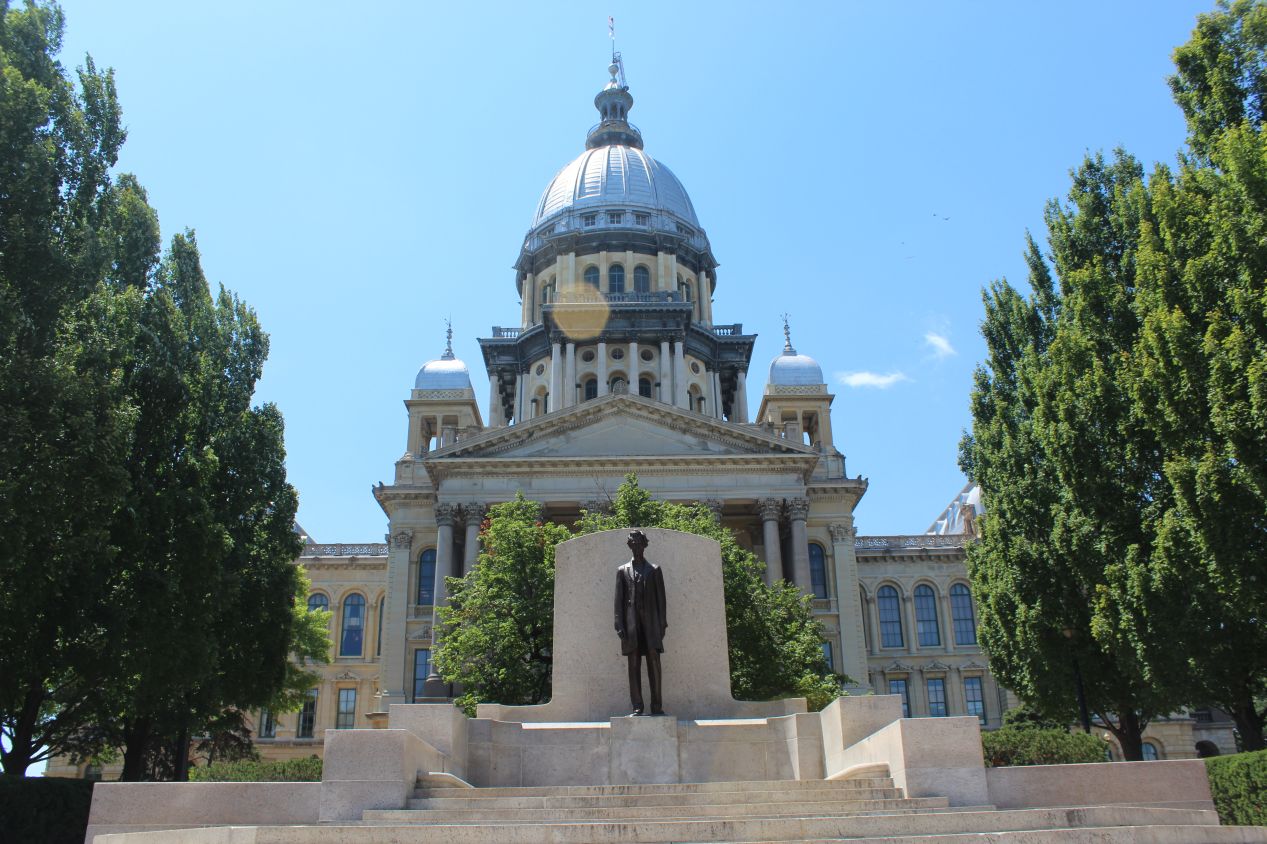


I spotted the Illinois State Capitol building several minutes before I arrived, with its towering height rising up above the mostly small buildings that dotted the downtown portion of Springfield. This is the replacement building for the Old State Capitol that I had visited earlier, and it's a vastly larger structure as compared to its more humble predecessor. Like the other state legislature buildings that I had been seeing throughout this trip, the Illinois State Capitol had a classically-inspired architectural theme, with Greek columns at the front entrance and a tall central dome. The dome on this building was the largest that I had seen to date, with a grayish off-white coloring and multiple tiers of height. The Illinois State Capitol building has a total height of 360 feet / 110 meters, and the dome here is actually taller than the one on the US Capitol building in Washington DC. The building was constructed between 1868 and 1888 over a period of two decades and no expenses were spared in its construction. For once, I would also have the chance to see the interior of this state capital and tour more than just the outside grounds.

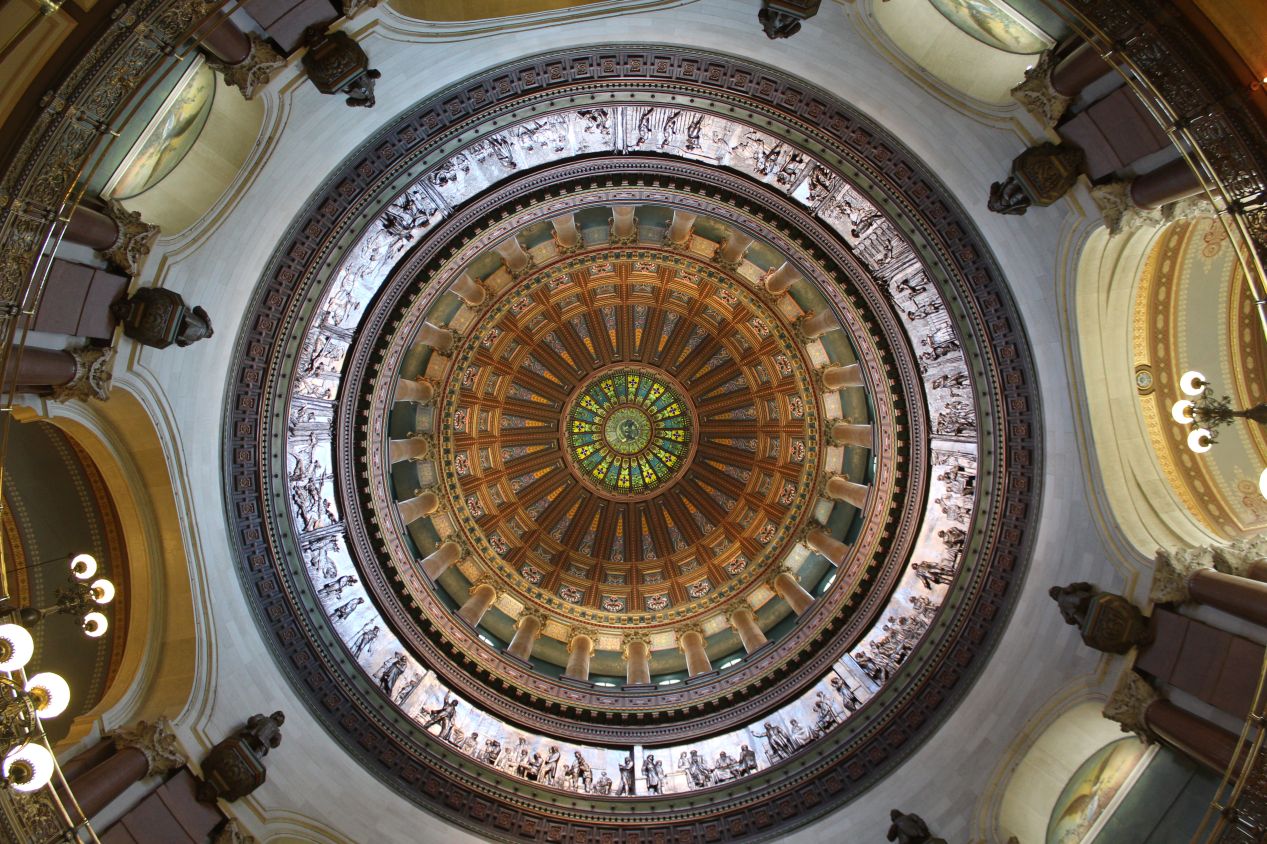


These are some pictures of the ornate interiors that I encountered upon entering at the ground floor level. While the exterior of the building had a classical feel, the interior felt like more of a luxurious Renaissance-inspired design, between all of the gilding and multiple different colors of marble in use. The view from directly underneath the dome looking up was pretty incredible, and it was clear from the intricate decorations why it had taken almost twenty years to build this place. Illinois has been one of the wealthiest states in the country for a very long time, largely due to the concentration of industry and finance in Chicago, and the Illinois State Capitol had that opulence on full display.

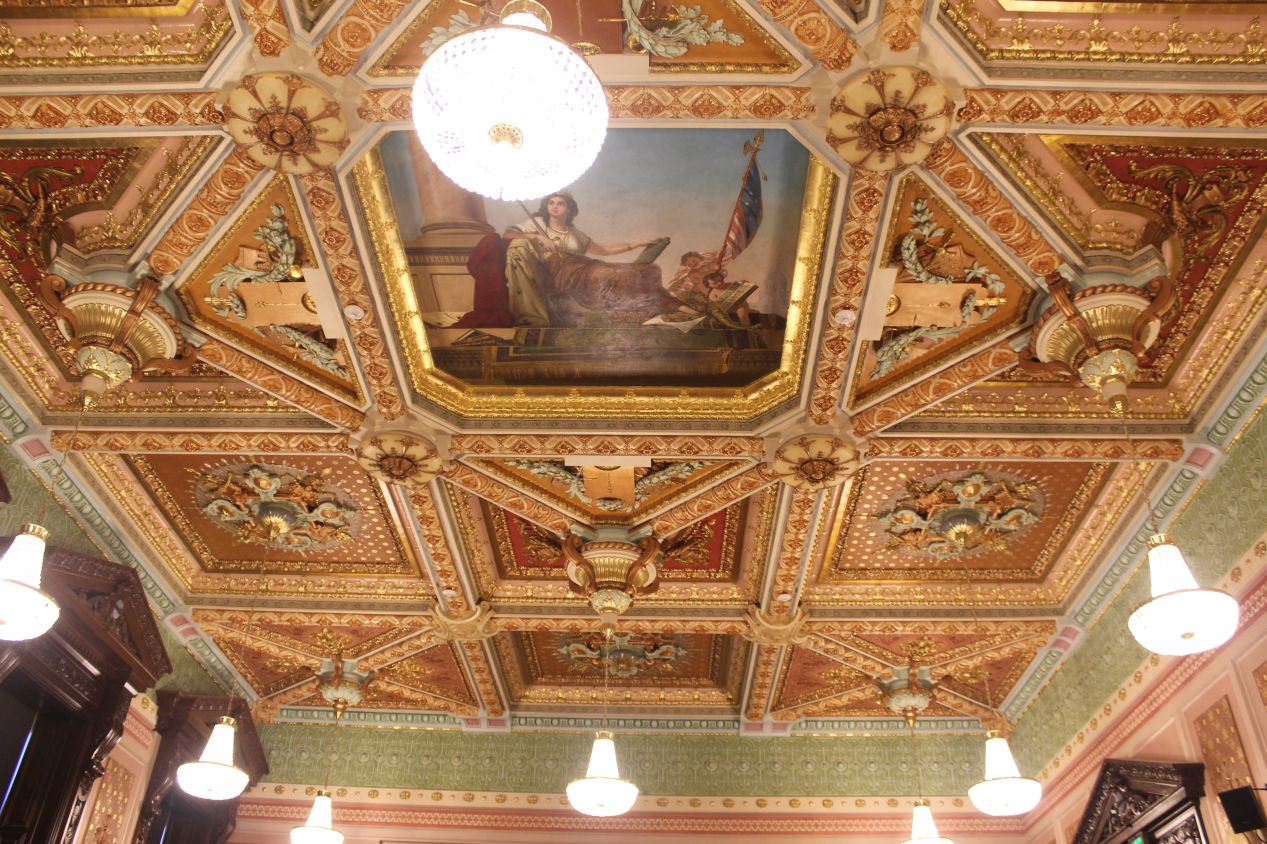


These pictures were mostly taken from the room housing the Illinois Supreme Court, which now meets in a far larger and fancier room than the one in the Old State Capitol. Illinois uses a setup with seven justices on the supreme court, although there were clearly far more than seven chairs behind the bench when I visited. I'm not sure what was going on with that setup. There were additional marble columns in the rear of the room to go along with the wood paneling, and a lavishly decorated ceiling that could have come out of a French chateau. That is, aside from the 19th century depiction of Columbia with an American flag as the centerpiece, which is a reference that no one uses any more. This was also the floor where the governor's office was located, although it was not open for visitors and I didn't see anything aside from a closed door with "governor" on the front. I also included another picture of the enormous central dome to get a look at some of the carvings that ran along its sides. I would have liked to get up to that upper walkway but that was only possible on guided tours, which I had missed out on. The view looking down from there must be incredible.

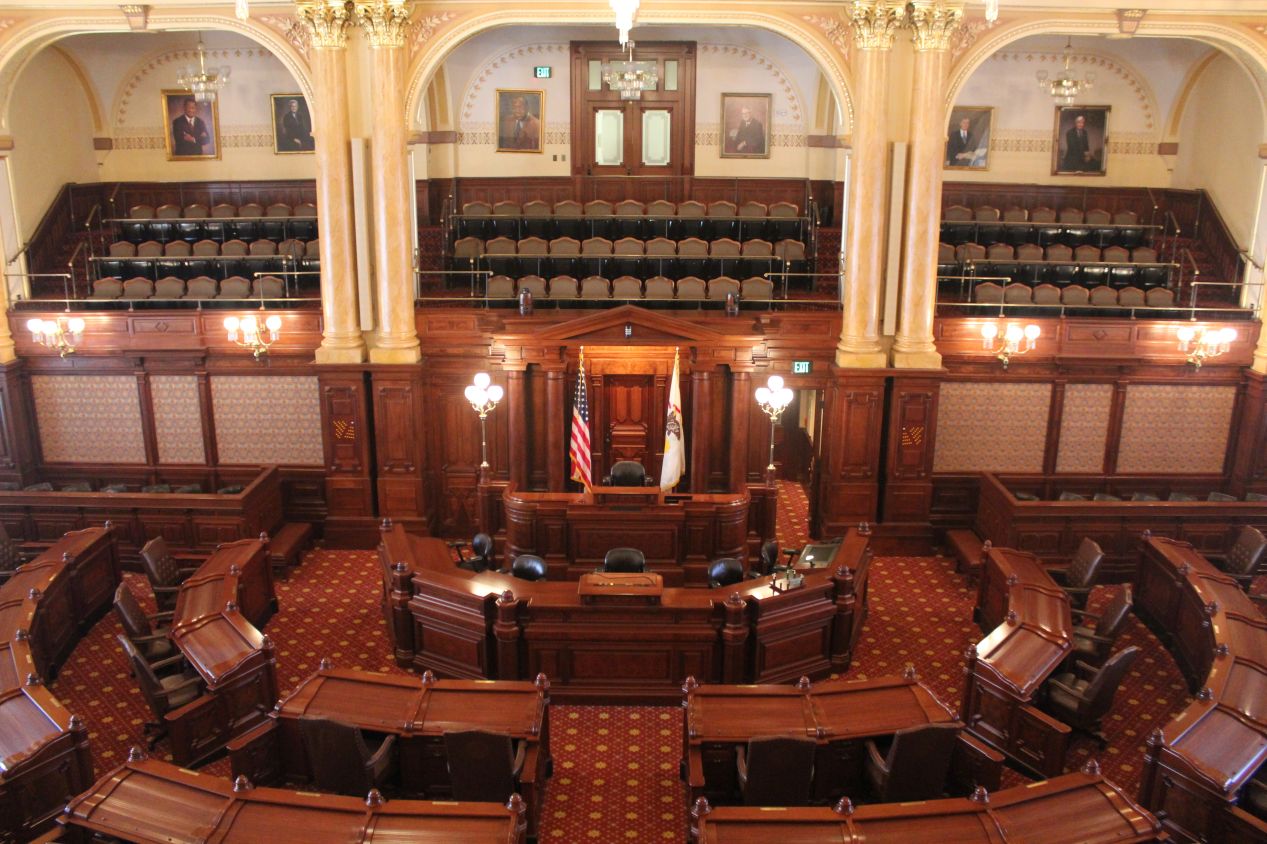


Then there were the two legislative chambers, which were both open for visitors to poke around inside. The first two pictures are from the Illinois Senate, the upper house of the legislature and the smaller of the two bodies. The Illinois Senate currently has the extremely odd number of 59 seats, with members each elected to four year terms. This room had the standard semicircular arrangement of American legislative chambers, with the benches extending outward in rows from the central podium. There were viewing galleries here both behind the seats and also behind the podium, and I felt that the furnishings here were a bit more refined than the somewhat gaudy nature of the displays elsewhere. The sign welcoming visitors to the Illinois Senate was a nice touch.
The other two pictures are from the lower chamber, the Illinois House of Representatives. This room looked similar to the Illinois Senate but was notably bigger to accomodate the larger size of the legislative body; the chandeliers on the ceiling were also bigger and fancier to match. The Illinois House of Representatives is exactly double the size of the Illinois Senate at 118 seats, with members elected to two year terms just like the US House of Representatives. Both chambers of the legislature were heavily Democratic at the time of my visit in 2018, as reflecting the overall political landscape of Illinois. The Illinois House of Representatives used to have an innovative multi-member voting system in which each voter could cast up to three votes, casting one apiece to three different candidates or casting all three votes for a single individual. That system was abolished in 1980 in favor of a standard first-past-the-post system, and that's a real shame. Multi-member electoral systems tend to create more dynamic politics and allow for more diverse voices to be represented. I'm not an Illinois resident but it feels like it would be pretty cool to bring this system back again.




After finishing up at the Illinois State Capitol, I walked a block to the south and stopped in to see the nearby Illinois State Museum. This was a local museum housing the collections of the Illinois Historical Society, but the low budget exhibits did a fine job of telling the history of the state. Most of the first floor was devoted to the natural history of the state, taking visitors through the changing climate of the region over the last few hundred million years and the effect that this has had on the flora and fauna that lived in the area. There was virtually nothing on dinosaurs here because most of Illinois was underwater during the Mesozoic period, but there were still plenty of interesting displays for kids to enjoy. Very educational for anyone who had an interest in the subject.
The second floor then continued with the cultural history of Illinois, starting with the Native Americans who had lived in the area and then continuing on through the frontier period and into the modern era. There were all sorts of artifacts on display that had some kind of historical significance; I think that my favorite was a piano cover from the 1890s put together by two teenage women who collected small fabric samples from the governors' wives of every state in the union. They sewed the piece together into a map of the USA and even managed to include a swatch of fabric from the wife of then-President Benjamin Harrison. I ended up spending about an hour in this museum and could have spent longer if I didn't want to get to my final sightseeing destination before it closed for the day.

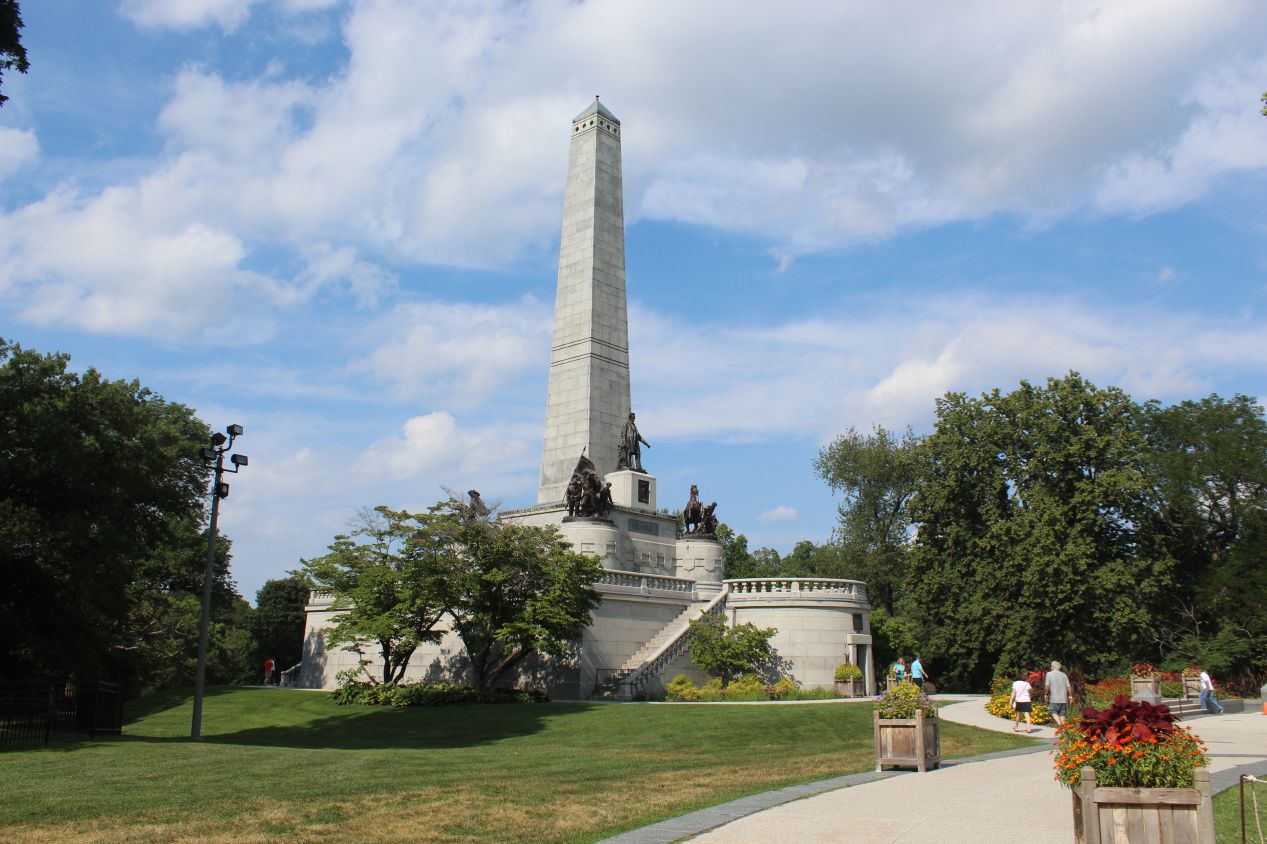


That final destination was the ultimate burial place of Abraham Lincoln, located in Oak Ridge Cemetery about two miles to the north of downtown Springfield. This is not a particularly well-known landmark and there were only about a dozen cars in the mostly-empty parking lot when I arrived in the late afternoon, about an hour before the place closed for the evening. The Lincoln Tomb was designed in the shape of an obelisk and built shortly after his death between 1868 and 1874. The base of the monument features a series of statues depicting soldiers in Civil War-era costume, with Lincoln in the central place of honor as the Commander in Chief. Visitors to the tomb enter a small door into a mausoleum situated directly below the obelisk.


There's a small bronze prototype casting of the statue used to sculpt the Lincoln Memorial in Washington DC at the entrance to the mausoleum, and visitors walk from there down a corridor until reaching the main room. A marble sarcophagus bears Abraham Lincoln's name in front of a series of flags and the immortal words pronounced by Edwin Stanton, Lincoln's Secretary of War, at the time of his death: "Now he belongs to the ages." Signs at the entrance to the tomb explained that Lincoln is not actually buried in the marble block, but has his final resting place in a vault underneath the floor. His wife Mary Todd Lincoln and their three sons that died in adolescence are also buried in the tomb, with only their eldest son Robert Lincoln buried elsewhere. When I visited, someone had left a small bundle of fresh flowers next to the sarcophagus which I found touching. This is a somber memorial but I was glad that I'd been fortunate enough to see it and pay my respects to the Lincolns. Abraham Lincoln is generally considered to be the greatest American president, and I hold a tremendous amount of respect for his courageous leadership during an incredibly difficult period for my country.

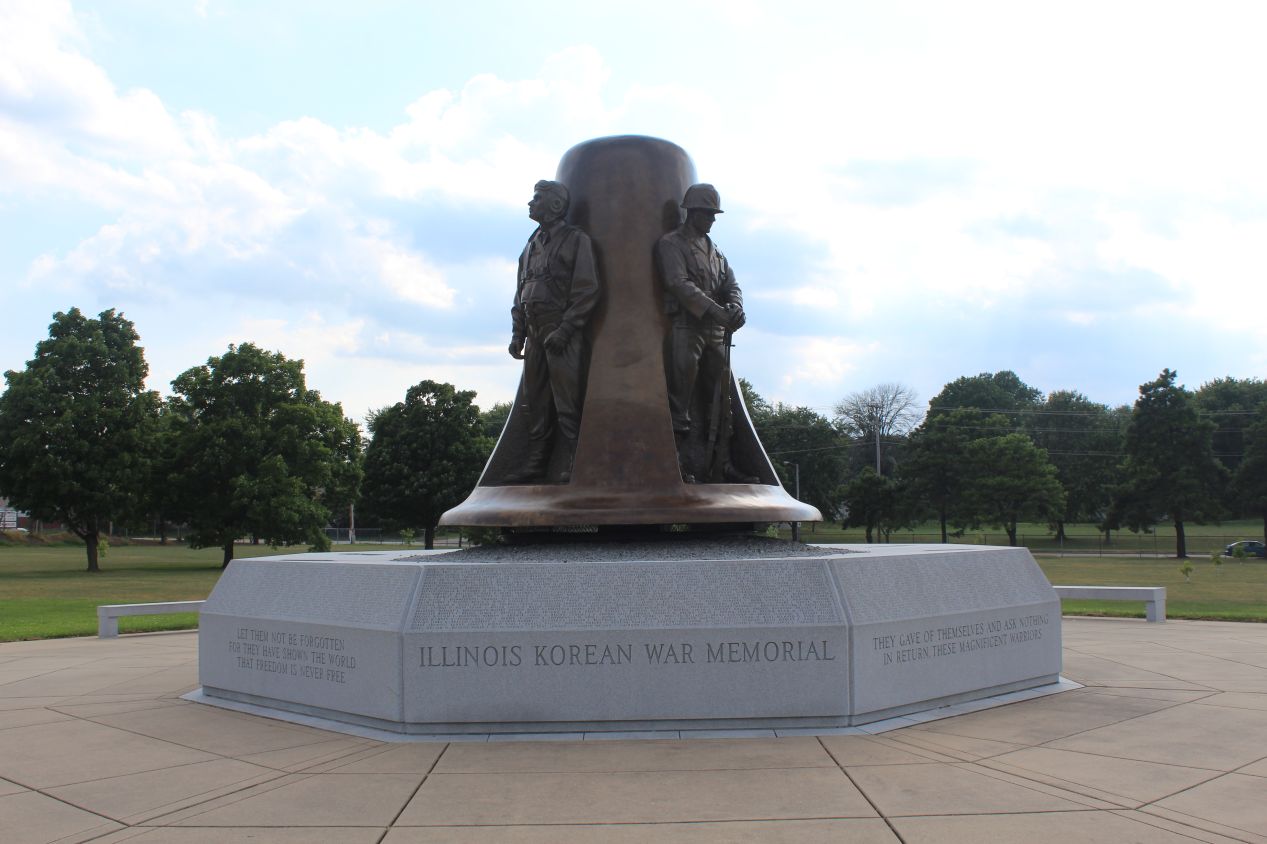


The rest of Oak Ridge Cemetery contains the graves of many Illinois veterans, and I noticed several additional monuments when I was preparing to leave. There was a Vietnam Veterans Memorial that honored the almost 3,000 Illinoisans who died in that conflict, and nearby a similar Korean War Memorial dedicated to the 1700 residents of the state who died in that earlier war. More recently, the cemetary added a World War II Illinois Veterans Memorial in 2004 to pay tribute to the much larger number of individuals who served in that conflict, with 987,000 Illinois men and women serving and 22,000 giving their lives. Unlike the small number of people at the Lincoln Tomb, there wasn't even a single soul here at this collection of memorials. I thought that it was only fair to spend a few minutes here to honor the dead from these overseas wars.
And on that note, my sightseeing trip to Springfield came to a close. This is a fantastic place to visit for anyone who has an interest in history, and particularly anyone who has a fondness for Lincoln. It's impossible to go anwhere in Springfield without some kind of mention of Lincoln popping up, as his name and likeness are displayed everywhere across the city. Between the Lincoln Home, the Lincoln Presidential Library, and the Lincoln Tomb, most of the attractions in Springfield revolve around the former president in some fashion. With these locations and the two Illinois state capitol buildings in the small city, there's definitely enough here to be worth a full day's worth of sightseeing... but probably no more than one day of sightseeing, if that makes sense. I wouldn't recommend spending more than a weekend in Springfield as it is a rather small city. For those with little interest in history, or if anyone out there dislikes Abraham Lincoln, well, this probably isn't the place to visit. From my perspective, it was one of my favorite spots that I experienced on this trip across America.



